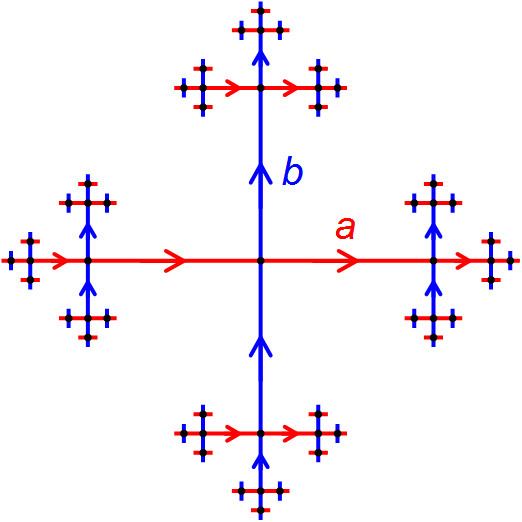 | ||
Geometric group theory is an area in mathematics devoted to the study of finitely generated groups via exploring the connections between algebraic properties of such groups and topological and geometric properties of spaces on which these groups act (that is, when the groups in question are realized as geometric symmetries or continuous transformations of some spaces).
Contents
Another important idea in geometric group theory is to consider finitely generated groups themselves as geometric objects. This is usually done by studying the Cayley graphs of groups, which, in addition to the graph structure, are endowed with the structure of a metric space, given by the so-called word metric.
Geometric group theory, as a distinct area, is relatively new, and became a clearly identifiable branch of mathematics in the late 1980s and early 1990s. Geometric group theory closely interacts with low-dimensional topology, hyperbolic geometry, algebraic topology, computational group theory and differential geometry. There are also substantial connections with complexity theory, mathematical logic, the study of Lie Groups and their discrete subgroups, dynamical systems, probability theory, K-theory, and other areas of mathematics.
In the introduction to his book Topics in Geometric Group Theory, Pierre de la Harpe wrote: "One of my personal beliefs is that fascination with symmetries and groups is one way of coping with frustrations of life's limitations: we like to recognize symmetries which allow us to recognize more than what we can see. In this sense the study of geometric group theory is a part of culture, and reminds me of several things that Georges de Rham practices on many occasions, such as teaching mathematics, reciting Mallarmé, or greeting a friend" (page 3 in ).
History
Geometric group theory grew out of combinatorial group theory that largely studied properties of discrete groups via analyzing group presentations, that describe groups as quotients of free groups; this field was first systematically studied by Walther von Dyck, student of Felix Klein, in the early 1880s, while an early form is found in the 1856 icosian calculus of William Rowan Hamilton, where he studied the icosahedral symmetry group via the edge graph of the dodecahedron. Currently combinatorial group theory as an area is largely subsumed by geometric group theory. Moreover, the term "geometric group theory" came to often include studying discrete groups using probabilistic, measure-theoretic, arithmetic, analytic and other approaches that lie outside of the traditional combinatorial group theory arsenal.
In the first half of the 20th century, pioneering work of Dehn, Nielsen, Reidemeister and Schreier, Whitehead, van Kampen, amongst others, introduced some topological and geometric ideas into the study of discrete groups. Other precursors of geometric group theory include small cancellation theory and Bass–Serre theory. Small cancellation theory was introduced by Martin Grindlinger in the 1960s and further developed by Roger Lyndon and Paul Schupp. It studies van Kampen diagrams, corresponding to finite group presentations, via combinatorial curvature conditions and derives algebraic and algorithmic properties of groups from such analysis. Bass–Serre theory, introduced in the 1977 book of Serre, derives structural algebraic information about groups by studying group actions on simplicial trees. External precursors of geometric group theory include the study of lattices in Lie Groups, especially Mostow rigidity theorem, the study of Kleinian groups, and the progress achieved in low-dimensional topology and hyperbolic geometry in the 1970s and early 1980s, spurred, in particular, by Thurston's Geometrization program.
The emergence of geometric group theory as a distinct area of mathematics is usually traced to the late 1980s and early 1990s. It was spurred by the 1987 monograph of Gromov "Hyperbolic groups" that introduced the notion of a hyperbolic group (also known as word-hyperbolic or Gromov-hyperbolic or negatively curved group), which captures the idea of a finitely generated group having large-scale negative curvature, and by his subsequent monograph Asymptotic Invariants of Infinite Groups, that outlined Gromov's program of understanding discrete groups up to quasi-isometry. The work of Gromov had a transformative effect on the study of discrete groups and the phrase "geometric group theory" started appearing soon afterwards. (see, e.g.,).
Modern themes and developments
Notable themes and developments in geometric group theory in 1990s and 2000s include:
- The study of properties that are invariant under quasi-isometry. Examples of such properties of finitely generated groups include: the growth rate of a finitely generated group; the isoperimetric function or Dehn function of a finitely presented group; the number of ends of a group; hyperbolicity of a group; the homeomorphism type of the Gromov boundary of a hyperbolic group; asymptotic cones of finitely generated groups (see, e.g.,); amenability of a finitely generated group; being virtually abelian (that is, having an abelian subgroup of finite index); being virtually nilpotent; being virtually free; being finitely presentable; being a finitely presentable group with solvable Word Problem; and others.
- Theorems which use quasi-isometry invariants to prove algebraic results about groups, for example: Gromov's polynomial growth theorem; Stallings' ends theorem; Mostow rigidity theorem.
- Quasi-isometric rigidity theorems, in which one classifies algebraically all groups that are quasi-isometric to some given group or metric space. This direction was initiated by the work of Schwartz on quasi-isometric rigidity of rank-one lattices and the work of Farb and Mosher on quasi-isometric rigidity of Baumslag-Solitar groups.
Examples
The following examples are often studied in geometric group theory:
